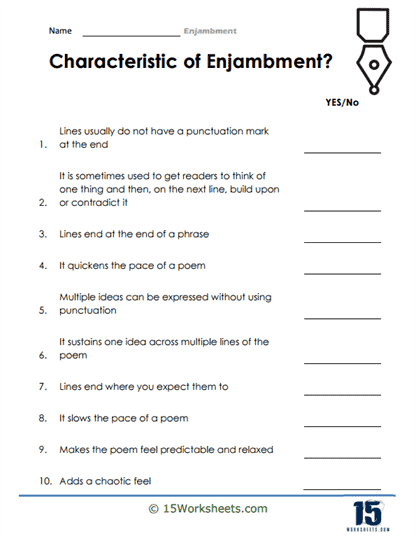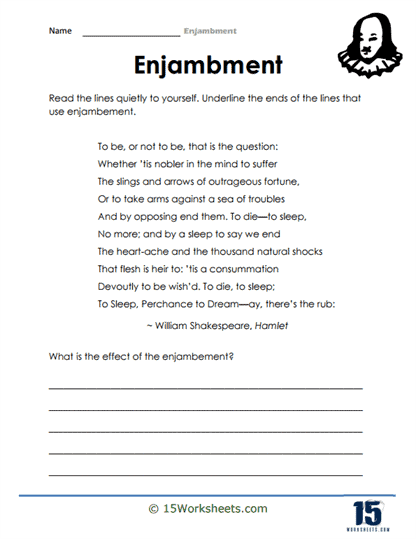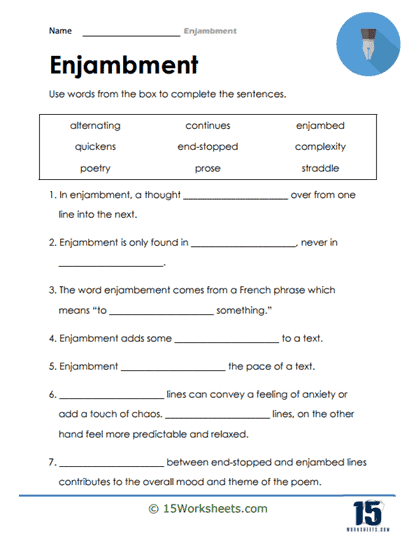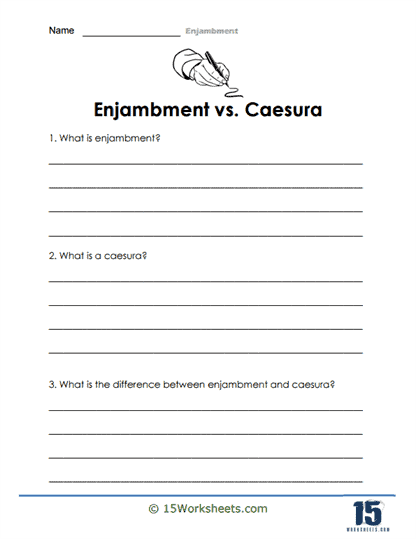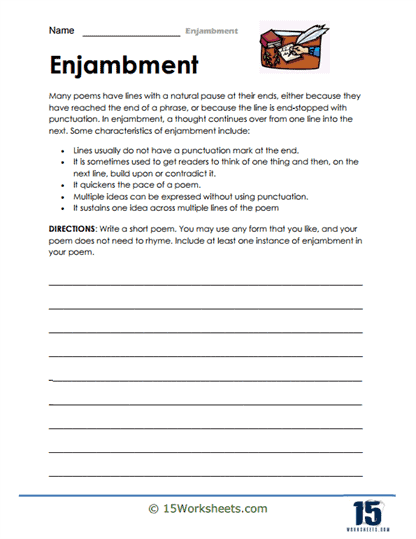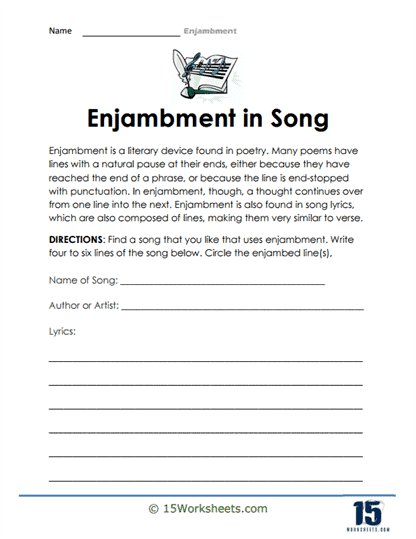Enjambment Worksheets
About These 15 Worksheets
Enjambment worksheets serve as educational tools designed to enhance students’ understanding and appreciation of poetry and its various stylistic elements. Enjambment, a literary device used in poetry, occurs when a sentence or phrase extends beyond one line and into the next without a terminal punctuation mark. This technique can affect the rhythm, pace, and meaning of the poem. By exploring enjambment worksheets, students delve into the intricacies of poetic structure, develop analytical skills, and foster a deeper appreciation for language arts.
Through a variety of exercises, these worksheets not only illuminate the technical aspects of poetry but also foster critical thinking, creative expression, and a profound appreciation for literary beauty. Engaging with enjambment and other poetic devices enhances students’ reading and interpretive skills, equipping them with the tools to explore the depths of language and its expressive potential.
Types of Exercises
Enjambment worksheets encompass a variety of exercises tailored to dissect and understand the use and impact of enjambment in poetry. These exercises include:
Identification Exercises – Students are provided with poems or excerpts and asked to identify instances of enjambment. This basic exercise helps students recognize how poets use this device to stretch ideas across lines and how it contributes to the overall structure of the poem.
Analysis Exercises – After identifying enjambment, students analyze its purpose and effect. They might discuss how it alters the rhythm, influences the reading pace, or enhances the poem’s thematic elements. This type of exercise encourages critical thinking and deepens students’ interpretive skills.
Comparison Exercises – These exercises involve comparing and contrasting poems with and without enjambment. Students evaluate how the presence or absence of enjambment affects the poem’s flow, mood, and meaning. This comparative analysis broadens students’ understanding of poetic techniques and their impacts.
Creation Exercises – Students apply what they’ve learned by writing their own poems using enjambment. This hands-on approach reinforces their understanding of the device and encourages creative expression.
Performance Exercises – Reading poetry aloud is an essential skill in understanding rhythmic and pacing elements. Students practice reading poems with enjambment aloud to explore how it influences oral interpretation. This exercise enhances pronunciation, intonation, and public speaking skills.
Reflection Exercises – Students reflect on the role of enjambment in conveying emotion and meaning within poetry. They might write short essays or participate in discussions about their personal reactions to poems and how enjambment contributes to their overall impact.
The Benefits of These Worksheets
Practicing with enjambment worksheets offers numerous benefits that contribute to students’ language arts and reading skills development:
Enhanced Comprehension – By dissecting how enjambment affects the structure and meaning of poems, students develop a nuanced understanding of poetic devices. This comprehension extends to a broader appreciation of literature and its various forms and styles.
Improved Analytical Skills – Analysis exercises encourage students to think critically about why poets choose enjambment and its effects on the reader’s experience. These analytical skills are transferable to other areas of study, promoting a deeper, more critical approach to reading and interpretation.
Creative Expression – Creation exercises stimulate students’ imagination and encourage them to experiment with their own poetic voices. Engaging in creative writing enhances their ability to express thoughts and emotions effectively and creatively.
Increased Vocabulary and Language Skills – Through exposure to diverse poetic works and the practice of writing, students encounter new vocabulary and language structures. This exposure broadens their linguistic repertoire and improves their overall language proficiency.
Better Public Speaking Skills – Performance exercises help students gain confidence in their speaking abilities. Reading aloud with attention to rhythm and pacing enhances their oral communication skills, beneficial in both academic and real-world settings.
Cultivated Appreciation for Poetry – By engaging deeply with poetic devices like enjambment, students develop a greater appreciation for poetry’s artistry and emotional power. This cultivated appreciation can lead to a lifelong engagement with literature and the arts.
What is the Literary Device of Enjambment?
Enjambment is a literary device widely recognized for its distinctive role in poetry and prose, where a sentence or clause stretches beyond the end of a line or stanza into the subsequent one without a closing punctuation mark. This technique forges a physical and cognitive bridge across lines, compelling the reader to move forward to grasp the full meaning of the sentence. Enjambment’s main defining feature lies in its ability to break the conventional boundaries of lines and stanzas, creating a seamless flow of thoughts and emotions that defy the visual constraints of the text.
Characteristics of Enjambment
Continuation Beyond Lines – The hallmark of enjambment is the continuation of a grammatical sentence or clause beyond the end of a line or stanza, inviting the reader to proceed to the next line to complete the thought.
Absence of Terminal Punctuation – Typically, enjambed lines do not conclude with punctuation marks; this absence propels the reader forward, maintaining the momentum of reading and understanding.
Impact on Rhythm and Pace – Enjambment can alter the natural rhythm and pace of the poem. It may speed up the reading process or create unexpected pauses, adding dynamism to the poem’s structure.
Emotional and Conceptual Linkage – This device often serves to link two concepts or emotions closely, emphasizing their relationship in a way that more segmented lines might not.
Visual and Aesthetic Appeal – Enjambment also plays a role in the poem’s visual layout, contributing to its overall aesthetic and the way it is experienced on the page.
Examples of Enjambment in Literature
Example 1 – “The Waste Land” by T.S. Eliot
In “The Waste Land,” Eliot masterfully employs enjambment to create a sense of disorientation and fragmentation, reflecting the chaos and disillusionment of the post-World War I era. For instance:
April is the cruelest month, breeding
Lilacs out of the dead land, mixing
Memory and desire, stirring
Dull roots with spring rain.
Here, the continuation of sentences across lines without terminal punctuation mirrors the tumultuous blend of memory and present desire, reflecting the poem’s theme of rebirth and decay. The enjambment compels the reader to move swiftly from one line to the next, mirroring the poem’s flowing and sometimes chaotic energy.
Example 2 – “Mending Wall” by Robert Frost
Frost’s use of enjambment in “Mending Wall” subtly underscores the poem’s themes of boundaries and the paradoxes of human connection:
Something there is that doesn’t love a wall,
That sends the frozen-ground-swell under it,
And spills the upper boulders in the sun;
The flow from one line to the next without pause reflects the natural forces that erode man-made boundaries, suggesting the artificiality and fragility of these divisions. The enjambment serves to draw attention to the poem’s contemplation on the necessity and futility of barriers, urging the reader to consider the deeper implications of maintaining separations.
Example 3 – “The Love Song of J. Alfred Prufrock” by T.S. Eliot
Eliot again employs enjambment to evoke the protagonist’s stream of consciousness and his inner turmoil:
And the afternoon, the evening, sleeps so peacefully!
Smoothed by long fingers,
Asleep… tired… or it malingers,
The continuation of thoughts across lines without clear demarcation mirrors Prufrock’s meandering thoughts, his uncertainties, and his hesitations. Enjambment reflects the fluidity of his consciousness and the blend of his emotions, enhancing the poem’s introspective quality.
The Effect of Enjambment on the Reader
Enjambment has a profound impact on the reader’s experience of a poem or prose piece. By stretching sentences across lines or stanzas, it:
Enhances Engagement – Enjambment encourages readers to engage more deeply with the text as they seek to understand the continuation of thoughts and sentences. This active engagement deepens the reader’s connection to the material.
Alters Rhythm and Pace – It significantly influences the poem’s rhythm and pacing, potentially accelerating the reader’s pace or creating moments of suspense as the sentence unfolds across lines. This manipulation of pace can heighten emotional responses and emphasize particular themes or images.
Facilitates Layered Meanings – The device can also create layered meanings, as the break between lines introduces a momentary pause that can add nuance or secondary interpretations to the text.
Visual Impact – Visually, enjambment shapes the reader’s perception of the poem, making the structure of the text an integral part of its meaning and impact.








